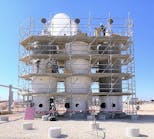Wisconsin Energy halves dividend, plans $6 billion in investments
Kate Thomas
OGJ Online
With state electricity demand growing 3%/year,Wisconsin Energy Corp., Milwaukee, said Sunday it will cut its dividend 50% to help finance a controversial $6 billion, 10-year plan to construct more electric generation, including new coal-fired plants; new distribution facilities; and upgrades to existing facilities.
Overall, the proposal, which has already generated criticism by Wisconsin consumer groups, includes spending about $3.3 billion on electric generation and $2.7 billion on distribution. The company, Wisconsin's largest energy provider, also said the board authorized an increase from $200 million to $400 million in the previously announced share repurchase program. WEC Chairman Richard A. Abdoo said the plan is intended to help boost earnings, resulting in "improved shareholder return through a higher share price.''
Through its primary utility subsidiaries Wisconsin Electric Power Co., Wisconsin Gas, and Edison Sault Electric Co., WEC serves more than 1 million electric and 940,000 natural gas customers in Wisconsin and Michigan's Upper Peninsula.
The "nontraditional" proposal will require close scrutiny by the Public Service Commission of Wisconsin (PSC), which is just concluding a horizontal market power study of the state electric industry for state legislature, says Jeff Butson, spokesman. The market power study was commissioned to determine the ability of a Wisconsin seller of electricity to constrain competition in a more deregulated electric market.
"We will have to do a little more investigating to determine which way to go with this proposal," he said. Butson said some of its ramifications will require state legislative actions. Because a proposed new subsidiary will keep all the profits in place of rates set by the PSC, the proposal is already "seeing opposition from consumer groups," Butson said.
Earlier in the year, the company received state regulatory approval to buy Wicor Inc. in exchange for a 5-year rate freeze beginning Jan. 1, 2000. The company will also receive $100 million as a result of spinning off its transmission system to the newly formed American Transmission System Co., a fledgling firm scheduled to take control of the electric transmission system of half a dozen companies by Nov. 1.
The company has also raised about $500 million from the sale of its interest in an Illinois independent power producers and business parks owned by its real estate arm.
New generation needed
WEC said its planners expect electricity demand in Wisconsin will outstrip capacity by approximately 4,000 Mw by 2010. It envisions spending about $2 billion on at least one 500 Mw combined cycle natural gas-fired unit and at least two 600 Mw coal-fired units over the next 10 years for a total of 1,700 Mw of new capacity. Additional units may be built after 2010 bringing the total to around 3,000 Mw of new electric generation capacity in the state, the company said.
The plan also includes an investment of more than $1.3 billion over a 10-year period in the company's existing portfolio of generating facilities and other capital projects to ensure continued reliable and cost efficient operation, as well as the retirement of older, less efficient coal-fired units.
As the state's base-load power plants continue to age and with nearly all the previously proposed units for Wisconsin relying on natural gas, Abdoo said WEC is proposing a fuel mix of coal and natural gas for the new units to enhance long-term fuel price stability and to allow electric customers in the state to take advantage of less costly electric energy. The company will also expand its use of renewable energy sources, WEC officials said.
"In planning for Wisconsin's energy future, we must be careful not to become too dependent on electricity generated by a single fuel,'' said Richard R. Grigg, president and chief operating officer of WEC unit Wisconsin Electric. "A mix that uses natural gas, coal, nuclear, hydro, renewables, and purchased power will help assure a more reliable and environmentally sensitive supply of electricity for Wisconsin consumers."
Subject to regulatory approval, WEC plans to begin construction of a natural gas-fired combined cycle unit in 2003 with completion in 2005. The first coal-fired unit would break ground in 2004 with a projected in-service date of 2007. The additional units would come on-line between 2009 and 2013.
Each new unit must go through a formal siting process, but WEC said Wisconsin Electric's 320 Mw coal-fired Port Washington power plant already has been identified as a candidate for conversion to a combined-cycle gas unit at the existing site.
The company said the Oak Creek power plant site has been identified as the preferred location for new coal-fired units, and the Pleasant Prairie power plant site has been identified as an alternate site. Internal review of other existing Wisconsin Electric power plant sites for new construction, conversion, or retirement is underway. officials said. The new units will permit the company to retire older, less efficient coal-fired units to reduce overall emissions from the company's portfolio of power plants, WEC said.
$2.7 billion on distribution
The plan includes an investment of about $2.7 billion over 10 years in the company's electric distribution system. The plan includes adding about 18 new substations, installing about 150,000 new electric service, building 2,500 miles of new rural distribution lines, rebuilding 60,000 miles of distribution line.
WEC said it will seek to restructure the generating portion of its current utility business to increase the leverage of existing assets by forming a generation subsidiary that will protect the company's utility customers by maintaining a balanced capital structure for Wisconsin Electric, while allowing Wisconsin Energy to make greater use of debt in financing the construction of new generation.
Effective Dec. 1, 2000, the company plans to reduce the quarterly dividend payable on shares of its common stock to 80�/share from $1.56/share annually. By reducing the dividend, the company will be able to reinvest in core business areas, reduce debt and lower borrowing costs, which will increase its overall financial strength, officials said.

